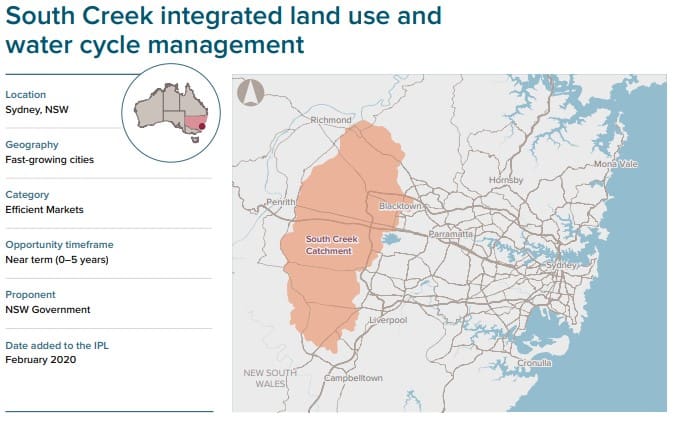Achieving a cool and green Western Parkland City (WPC) in the South Creek corridor that is able to catalyse the significant investment being made in the Western Sydney Airport and compete successfully with the more established Eastern Harbour City (centred around Sydney Harbour), and Central River City (centred around Parramatta River) will require ‘city shaping’ investment in blue-green infrastructure in the Western Parkland City. This involves conserving, investing in and actively maintaining ‘green’ infrastructure (such as urban canopy, open space) as well as blue infrastructure (water-related infrastructure such as waterways and stormwater management) to support and promote amenity, recreation, urban cooling and environmental outcomes.
Against this backdrop, Frontier Economics is assisting Infrastructure NSW with the South Creek Sector Review to develop regulatory certainty for integrated water and land-use planning.
The path chosen for the development of the WPC will affect national productivity, the quality of life for people living and working in Western Sydney and the value that can be created from existing and new infrastructure. Developing and sustaining a competitive, liveable and resilient city presents a complex set of land use and water management challenges, and there are significant economic, environmental and liveability-related challenges to achieving the WPC vision.
Recognising the national significance of delivering the WPC, the catalytic nature of blue-green infrastructure and this unique opportunity to shape the future of Western Sydney, Infrastructure Australia today announced that blue-green infrastructure in the Western Parkland City will be added as an initiative on the Infrastructure Priority List (a prioritised list of nationally significant investments). This is one of the first blue-green infrastructure investments to be listed on the Priority List, which has traditionally focused on grey infrastructure investments.

Frontier Economics assisted Infrastructure NSW in developing the submission to Infrastructure Australia’s Infrastructure Priority List and is advising a range of clients on economic issues and challenges in urban growth and development.
Image Credit: Infrastructure Australia: 'Infrastructure Priority List 2020'.
The Federal Court of Australia (FCA) today granted approval for TPG and Vodafone Hutchison Australia (VHA) to proceed with their proposed merger, combining the fixed-line communications and mobile assets of the two businesses. VHA had sought authorisation from the Court to allow the transaction to proceed following the Australian Competition and Consumer Commission’s (ACCC) rejection of the proposed merger during its informal merger clearance deliberations.
The ACCC – both in rejecting informal merger clearance and in arguing that authorisation should not be granted – stated its belief that the proposed transaction raised competition concerns. The ACCC argued that in the absence of the merger TPG would enter the mobile market as a mobile network operator, and that the merger would therefore substantially reduce competition in the retail mobile. Prior to the merger announcement TPG had announced its intention to deploy a mobile network. However, subsequent to the merger announcement TPG announced that it would cease the network deployment, citing the Government’s prohibition on the use of Huawei equipment in 5G networks.
In handing down its judgement the FCA dismissed these concerns, finding that in the absence of the merger TPG would not be likely to deploy a mobile network: "TPG's ship has sailed in the retail mobile market in Australia."
Frontier Economics (Asia-Pacific) and Frontier Economics (Europe) were retained by solicitors for the merging parties – Herbert Smith Freehills and Norton Rose Fulbright– to provide expert economic and competition policy advice and modelling as input to both informal merger clearance submissions as well as its application to the FCA requesting authorisation. Prof. Stephen Gray appeared before the FCA as an expert witness on behalf of VHA, Mr David Foster appeared before the FCA as an expert witness on behalf of TPG and Mr Warwick Davis submitted an expert report to the Court on behalf of TPG.
Frontier Economics regularly advises clients on a range of competition matters.
Introduction
In September 1990, Scientific American published a special issue entitled ‘Energy for Planet Earth’. In this publication, Scientific American explored the sources of energy, the future for energy, made predictions on technological breakthroughs and suggested solutions for what they considered was an imminent energy crisis.
Many of these predictions by Scientific American were made for 2020. Given we have reached that date, we can look back and compare the predictions with what actually happened. In a three-part series, Frontier Economics will compare actual outcomes to 2020 with the predictions made by Scientific American.
This comparison of actual versus predicted outcomes, especially where technological change is involved, can help us learn about the factors that have been determinative to the global community and provide guidance on how we can improve economic forecasts.
We focus on three areas where Scientific American made long term forecasts:
- Primary energy demand
- Energy intensity
- Emissions intensity
Each of these will be the subject of a separate note. This note examines the performance of Scientific American’s forecast of primary energy demand.
To view the full report, download the publication via the button below.
DOWNLOAD FULL PUBLICATION
